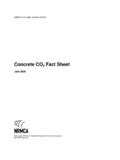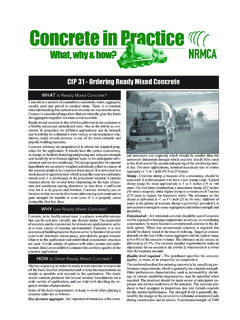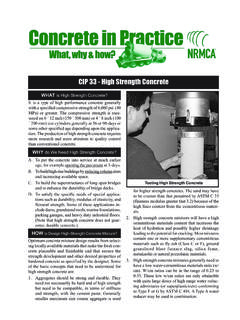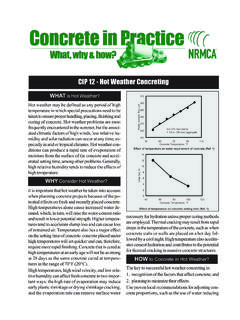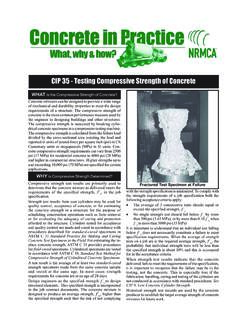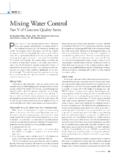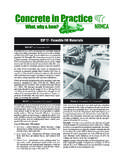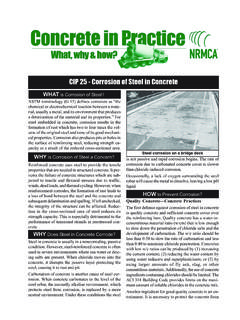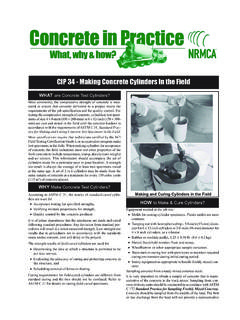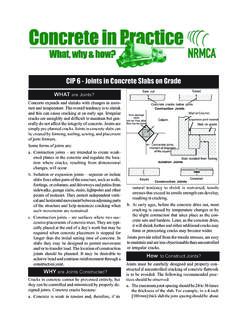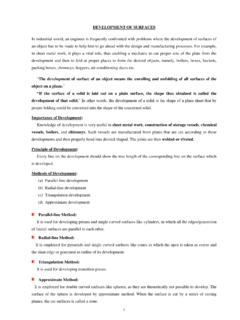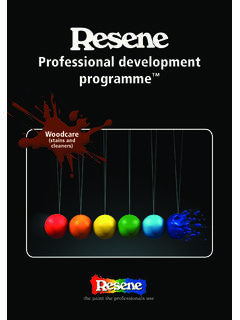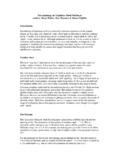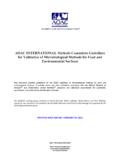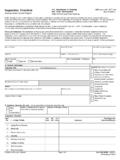Transcription of CIP 3 - Crazing Concrete Surfaces
1 CIP 3 - Crazing Concrete SurfacesWHY Do Concrete Surfaces Craze?WHAT is Crazing ? Crazing is the development of a network of fine ran-dom cracks or fissures on the surface of Concrete ormortar caused by shrinkage of the surface layer. Thesecracks are rarely more than 1/8 inch [3 mm] deep andare more noticeable on steel-troweled Surfaces . Theirregular hexagonal areas enclosed by the cracks aretypically no more than 11/2 inch [40 mm] across andmay be as small as 1/2 or 3/8 inch [12 or 20 mm] inunusual instances. Generally, craze cracks develop atan early age and are apparent the day after placementor at least by the end of the first week. Often they arenot readily visible until the surface has been wettedand it is beginning to dry cracks are sometimes referred to as shallowmap or pattern cracking.
2 They do not affect thestructural integrity of Concrete and rarely do theyaffect durability or wear resistance. However, crazedsurfaces can be unsightly. They are particularly con-spicuous and unsightly when Concrete contains cal-cium chloride, a commonly used accelerating steel-troweled slab Surfaces often have crazecracks due to shrinkage of the concentrated densepaste layer at the surface. Concrete surface crazingcan also occur because one or more of the rules of good Concrete practices were not followed. Themost frequent factors when Crazing occurs are:a. Poor or inadequate curing. Environmental condi-tions conducive to high evaporation rates, such aslow humidity, extremes in ambient temperature, di-rect sunlight, and drying winds on a Concrete sur-face when the Concrete is just beginning to gainstrength, cause rapid surface drying resulting incraze cracking.
3 Avoid the delayed application ofcuring or even intermittent wet curing and dryingafter the Concrete has been Too wet a mix, excessive floating, the use of a jit-terbug or procedures that will depress the coarseaggregate and produce an excessive concentrationof cement paste and fines at the Finishing operations performed while bleed waterremains on the surface or the use of a steel trowelin a manner that the smooth surface of the trowelbrings up excessive water and cement fines. Useof a bull float or darby with water on the surface orwhile the Concrete continues to bleed will producea high water-cement ratio at the surface resulting ina weak surface layer that will be susceptible to craz-ing, dusting, scaling and other surface Sprinkling cement on the surface to dry up thebleed water is a frequent cause of Crazing .
4 Thisconcentrates fines on the surface. Spraying wateron the Concrete surface during finishing operationswill result in a weak surface susceptible to crazingor Concrete Surface (Dampened)1978, 1989, 1998, 2009 HOW to Prevent Crazing ?a. To prevent Crazing , start curing the Concrete as soonas possible. Curing retains moisure required forproper reaction of cement with water, called hy-dration. Keep the surface wet by either floodingwith water or by covering it with damp burlap andkeeping it continuously moist for a minimum of 3days. An alternative is to spray the surface with aliquid-membrane curing compound. Avoid alter-nate wetting and drying of Concrete Surfaces at anearly age..b. When placing, use moderate slump (3 to 5 inches[75 to 125 mm]) Concrete .
5 Higher slump (up to 6or 7 inches [150 to 175 mm]) can be used pro-vided the mixture is designed to produce the re-quired strength without excessive bleeding and/orsegregation. This is generally accomplished by us-ing water-reducing sprinkle or trowel dry cement or a mix-ture of cement and fine sand on the surface of theplastic Concrete to absorb bleed water. DO NOTsprinkle water on the slab to facilitate finishing. Ifnecessary, remove bleed water by dragging a gar-den hose across the NOT performany finishing operation while bleed water is presenton the surface or before the bleeding process NOT overwork or over-finish When high evaporation rates are anticipated, lightlydampen the subgrade prior to Concrete placementto prevent it absorbing too much water from theconcrete.
6 If a vapor retarder is required on thesubgrade, cover it with 3 to 4 inches of a com-pactible, granular fill, such as a crusher-run mate-rial except when the slab will receive a vapor-sen-sitive floor covering or will be in a humidity con-trolled environment. See CIP 29 that discusses thelocation of vapor for Concrete Floor and Slab Construction, , American Concrete Institute, Farmington Hills, Slab Surface Defects: Causes, Prevention,Repair, IS 177T, Portland Cement Association, Skokie, Ward Malisch, Avoiding Common Outdoor FlatworkProblems, Concrete Construction, July Ralph Spannenberg, Use the Right Tool at the Right Time, Concrete Construction, May These Rules to Prevent Crazing1. Use moderate slump (3-5 inches) Concrete with reduced bleeding Follow recommended practices and timing, based on Concrete setting characteristics, for placing andfinishing operations:a.
7 Avoid excessive manipulation of the surface, which can depress the coarse aggregate, increase thecement paste at the surface, or increase the water-cement ratio at the NOT finish Concrete before the Concrete has completed bleeding (look for the presence of a watersheen on the surface). DO NOT dust any cement onto the surface to absorb bleed water. DO NOTsprinkle water on the surface while finishing Cure properly as soon as finishing has been completed.
